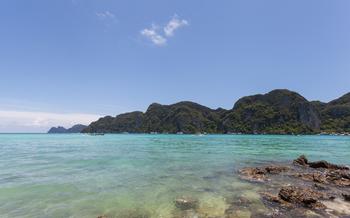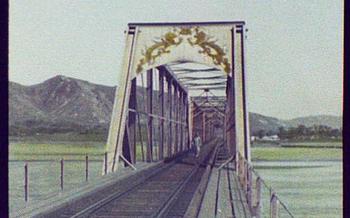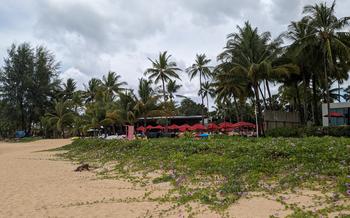
Mangrove Forest Conservation Center
- About the Mangrove Forest Conservation Center
- Reasons to Visit the Mangrove Forest Conservation Center
- Things to Do at the Mangrove Forest Conservation Center
- Guided Tours of the Mangrove Forest Conservation Center
- Hiking in the Mangrove Forest Conservation Center
- Best Time to Visit the Mangrove Forest Conservation Center
- How to Get to the Mangrove Forest Conservation Center
- From Ranong Town
- From Other Parts of Thailand
- From Neighboring Countries
- Cost of Visiting the Mangrove Forest Conservation Center
- Facilities at the Mangrove Forest Conservation Center
- What to Bring to the Mangrove Forest Conservation Center
- Safety Tips for Visiting the Mangrove Forest Conservation Center
- Insider Tips for Visiting the Mangrove Forest Conservation Center
- Additional Tips for Visiting Ranong
- Insider Tip: Visit During the Dry Season
About the Mangrove Forest Conservation Center
The Mangrove Forest Conservation Center is a unique and fascinating place that is dedicated to preserving the natural beauty and biodiversity of the Ranong mangrove forests. The center was established in 1994 by the Royal Forest Department of Thailand and is located in the tambon Pak Nam of the Muang district. It covers an area of approximately 1,200 hectares and is home to various mangrove species, wildlife, and marine life.
The main goal of the center is to protect and conserve the mangrove forests and to promote sustainable use and management of these ecosystems. The center conducts research and conservation programs, provides education and awareness programs for the local community and visitors, and works to restore degraded mangrove areas.
The center is located approximately 10 kilometers south of Ranong town, on the Pak Nam Ranong River. It is easily accessible by boat or car. Visitors can explore the center's mangrove forests via guided tours, hiking trails, and paddling excursions. The center also has a museum that exhibits information about the mangrove ecosystem, its importance, and the conservation efforts being undertaken.
Reasons to Visit the Mangrove Forest Conservation Center
The Mangrove Forest Conservation Center is a must-visit destination for nature lovers and conservationists alike. Here are a few reasons why you should visit this unique and fascinating place:
The unique ecosystem: Mangrove forests are one of the most unique and diverse ecosystems on Earth. They are home to a wide variety of plants and animals, many of which are found nowhere else in the world. The center provides a safe haven for these unique species and allows visitors to learn about their importance in the ecosystem.
The beautiful scenery: The mangrove forest is a beautiful and serene place. The tall, green trees with their intricate root systems create a magical atmosphere. The center has several observation platforms that offer stunning views of the forest and the surrounding area.
The variety of activities: There are a variety of activities that visitors can enjoy at the center. These include guided tours, hiking, paddling through the mangroves, and visiting the museum. The center also offers educational programs for schools and groups.
Things to Do at the Mangrove Forest Conservation Center
At the Mangrove Forest Conservation Center, you'll find plenty of things to do that will immerse you in the unique ecosystem of the mangroves. Here are a few ideas to make the most of your visit:
-
Take a guided tour: Learn about the history, ecology, and conservation efforts of the mangrove forest from a knowledgeable guide. Guided tours are available in various languages and can be booked in advance or upon arrival.
-
Hike through the forest: Explore the mangrove forest on foot along well-marked trails. You'll encounter towering trees, winding creeks, and a variety of wildlife along the way.
-
Paddle through the mangroves: Rent a kayak or a paddleboard and glide through the tranquil waters of the mangrove forest. This is a great way to get up close to the trees and spot wildlife.
-
Visit the museum: Learn more about the importance of mangrove forests and the conservation work being done at the center through interactive exhibits and displays. The museum is a great place to start your visit or end your day.
Guided Tours of the Mangrove Forest Conservation Center
Guided tours of the Mangrove Forest Conservation Center are available to visitors who want to learn more about the mangroves and the center's conservation efforts. Tours are led by experienced guides who can provide information about the different types of mangroves, the wildlife that lives in the forest, and the importance of mangrove ecosystems.
Information on Booking a Guided Tour: - To book a guided tour, visitors can contact the center in advance via phone or email. - Advance bookings are highly recommended, especially if you're part of a large group. - Guided tours are available in both Thai and English.
Highlights of the Guided Tour: - During the guided tour, visitors will be taken through the different parts of the mangrove forest, including the boardwalk, the observation tower, and the museum. - Visitors will learn about the different types of mangroves, the wildlife that lives in the forest, and the importance of mangrove ecosystems. - The guided tour also includes a boat ride through the mangroves, where visitors can see the forest from a different perspective.
Cost of the Guided Tour: - Guided tours of the Mangrove Forest Conservation Center are reasonably priced, making it a great value for visitors. - The cost of the guided tour may vary depending on the group size and the length of the tour. - It is recommended to check with the center for the most up-to-date information on guided tour prices.
Hiking in the Mangrove Forest Conservation Center
The Mangrove Forest Conservation Center offers a variety of hiking trails that wind through the lush mangrove forest. These trails range in difficulty from easy to challenging, so there is something for everyone. Some of the most popular hiking trails include the Mangrove Forest Loop Trail, the Bird Watching Trail, and the Beach Trail.
The Mangrove Forest Loop Trail is a 2-kilometer loop trail that takes about an hour to complete. This trail is relatively easy and is suitable for all fitness levels. The trail winds through the mangrove forest and offers views of the diverse plant and animal life.
The Bird Watching Trail is a 1-kilometer trail that takes about 30 minutes to complete. This trail is perfect for birdwatchers, as it is home to a variety of bird species. The trail winds through the forest and along the edge of the lagoon, offering views of the birds in their natural habitat.
The Beach Trail is a 3-kilometer trail that takes about an hour to complete. This trail is more challenging than the other two trails, as it includes some steep hills. However, the trail is worth the effort, as it offers stunning views of the Andaman Sea.
When hiking in the mangroves, it is important to be aware of the tides. The tides can change quickly, and it is possible to get stranded if you are not careful. It is also important to be careful of wildlife. There are a variety of animals that live in the mangroves, including snakes, crocodiles, and monkeys. It is important to stay on the marked trails and to be aware of your surroundings.
Best Time to Visit the Mangrove Forest Conservation Center
The best time to visit the Mangrove Forest Conservation Center is during the dry season, which runs from November to April. During this time, the weather is cool and dry, with average temperatures ranging from 20 to 30 degrees Celsius. The humidity is also lower, making it more comfortable to explore the mangroves. Additionally, the mosquitoes are not as bad during the dry season, making it a more pleasant experience overall.
During the rainy season (May to October), the weather can be hot and humid, with frequent thunderstorms. The trails can also be muddy and slippery, making it more difficult to hike. However, the rainy season is also the time when the mangroves are at their greenest, and the wildlife is most active.
If you are interested in seeing wildlife, the best time to visit the Mangrove Forest Conservation Center is during the early morning or late afternoon, when the animals are most active. You may be able to spot waterbirds, monitor lizards, and even the occasional otter.
The Mangrove Forest Conservation Center also hosts a number of special events throughout the year, such as birdwatching tours, kayaking excursions, and educational workshops. Check the center's website for a list of upcoming events.
How to Get to the Mangrove Forest Conservation Center
From Ranong Town
- By Songthaew: You can take a songthaew (shared taxi) from Ranong town to the mangrove forest conservation center. The journey takes about 30 minutes and costs around 100 baht per person.
- By Taxi: You can also take a taxi from Ranong town to the mangrove forest conservation center. The journey takes about 20 minutes and costs around 200 baht.
From Other Parts of Thailand
- By Bus: There are several buses that run from Bangkok and other parts of Thailand to Ranong. Once you arrive in Ranong, you can take a songthaew or taxi to the mangrove forest conservation center.
- By Train: There is no train station in Ranong. However, you can take a train to Surat Thani and then take a bus or taxi to Ranong.
From Neighboring Countries
- By Car: If you are driving from a neighboring country, you can cross the border into Ranong. Once you are in Ranong, you can follow the signs to the mangrove forest conservation center.
- By Bus: There are several buses that run from neighboring countries to Ranong. Once you arrive in Ranong, you can take a songthaew or taxi to the mangrove forest conservation center.
Cost of Visiting the Mangrove Forest Conservation Center
Visiting the Mangrove Forest Conservation Center is relatively affordable. The entrance fee is 100 Thai Baht for adults and 50 Thai Baht for children. Guided tours cost an additional 200 Thai Baht per person. Other activities, such as kayaking and paddleboarding, may also incur additional fees.
It is important to note that the center does not accept credit cards, so be sure to bring cash or use a debit card. There is also a small gift shop at the center where you can purchase souvenirs and snacks.
Here is a breakdown of the costs:
Entrance fee: 100 Thai Baht (Adults), 50 Thai Baht (Children) Guided tour: 200 Thai Baht per person Kayaking or paddleboarding: 100 Thai Baht per hour Souvenirs and snacks: Variable, depending on what you purchase
Overall, you can expect to spend around 300-500 Thai Baht for a visit to the Mangrove Forest Conservation Center, depending on the activities you choose to participate in.
Facilities at the Mangrove Forest Conservation Center
The Mangrove Forest Conservation Center is equipped with a variety of facilities to enhance the visitor experience and ensure their comfort during their visit.
At the entrance of the center, visitors will find a visitor center that provides information about the mangrove forest ecosystem, the center's activities, and the local culture. Knowledgeable staff is on hand to answer any questions and help visitors plan their visit.
The center also has a gift shop where visitors can purchase souvenirs and handicrafts made from local materials. These items not only serve as mementos of the visit but also support the local economy and promote conservation efforts.
For those who need to refuel, the center offers a restaurant serving a variety of Thai and international dishes. The menu features fresh seafood, local produce, and traditional Thai flavors. Visitors can enjoy their meals while taking in the beautiful views of the mangrove forest.
Restrooms are conveniently located throughout the center to ensure that visitors have access to clean and well-maintained facilities.
The Mangrove Forest Conservation Center strives to create a welcoming and accessible environment for all visitors. With its comprehensive facilities, the center ensures that visitors have a comfortable and enjoyable experience while learning about the importance of mangrove forests and the conservation efforts underway.
What to Bring to the Mangrove Forest Conservation Center
When visiting the Mangrove Forest Conservation Center, it's essential to come prepared with the right gear to ensure a comfortable and enjoyable experience. Here's a list of items to consider bringing:
-
Clothing: Choose lightweight, breathable fabrics that will keep you cool and dry in the humid climate. Long-sleeved shirts and pants are recommended to protect your skin from the sun and insects.
-
Footwear: Wear sturdy, closed-toe shoes or hiking boots for protection while walking on uneven terrain. Avoid sandals or flip-flops, as they can be slippery and increase your risk of injury.
-
Sunscreen: The sun can be intense in Ranong, so apply sunscreen liberally to protect your skin from harmful UV rays. Choose a broad-spectrum sunscreen with an SPF of 30 or higher.
-
Bug spray: Insects, particularly mosquitoes, can be present in the mangroves, so bring bug spray to keep them at bay. Choose a repellent with DEET or another effective insect repellent.
-
Water bottle: It's essential to stay hydrated, especially in the hot and humid climate of Ranong. Bring a reusable water bottle and fill it up at the visitor center or one of the restaurants.
Safety Tips for Visiting the Mangrove Forest Conservation Center
The Mangrove Forest Conservation Center is a safe place to visit, but there are a few things you should keep in mind to ensure your safety.
- Be aware of the tides. The tides in the mangroves can change quickly, so it is important to be aware of the tide times before you go. If you are caught in a rising tide, you could be stranded.
- Be careful of wildlife. The mangroves are home to a variety of wildlife, including snakes, crocodiles, and monkeys. While these animals are generally not aggressive, it is important to be aware of their presence and to take precautions to avoid them.
- Stay on the marked trails. The trails in the mangroves are well-marked, and it is important to stay on them. If you wander off the trails, you could get lost or injured.
- Respect the environment. The mangroves are a fragile ecosystem, and it is important to respect the environment while you are visiting. Do not litter, and do not disturb the plants or animals.
Insider Tips for Visiting the Mangrove Forest Conservation Center
-
Visit during the weekdays to avoid crowds: The Mangrove Forest Conservation Center is a popular tourist destination, especially on weekends and holidays. If you want to avoid the crowds, try to visit during the weekdays. You'll have a more peaceful and enjoyable experience.
-
Take your time and enjoy the scenery: The Mangrove Forest Conservation Center is a beautiful place. Take your time to walk through the forest, admire the scenery, and listen to the sounds of nature. You may even see some wildlife along the way.
-
Bring your camera to capture the beautiful views: The Mangrove Forest Conservation Center is a great place to take photos. Bring your camera to capture the beautiful scenery, the wildlife, and the unique plants. You'll have some amazing memories to share with your friends and family.
-
Learn about the importance of mangrove forests: The Mangrove Forest Conservation Center is a great place to learn about the importance of mangrove forests. There are exhibits and educational programs that teach visitors about the role that mangrove forests play in the environment. You'll leave the center with a greater appreciation for these unique ecosystems.
Additional Tips for Visiting Ranong
In addition to visiting the Mangrove Forest Conservation Center, there are many other things to see and do in Ranong. Here are a few additional tips to make the most of your trip:
-
Consider visiting other attractions in Ranong. In addition to the Mangrove Forest Conservation Center, Ranong is home to several other attractions, including the Ranong Hot Springs, the Khao Ngao Wildlife Sanctuary, and the Raksawarin Waterfall.
-
Try the local cuisine. Ranong is known for its delicious seafood dishes, such as crab curry, grilled shrimp, and steamed fish. Be sure to try some of the local specialties while you're in town.
-
Bring a hat and sunglasses to protect yourself from the sun. Ranong can be very hot and sunny, so it's important to protect yourself from the elements.
-
Learn a few basic Thai phrases. Learning a few basic Thai phrases will help you communicate with the locals and get around more easily.
Insider Tip: Visit During the Dry Season
If you want to make the most of your visit to the Mangrove Forest Conservation Center, plan your trip during the dry season, which runs from November to April. During this time, the weather is typically cool and dry, with little to no rain. This makes for ideal conditions for exploring the forest, as the trails are not muddy or slippery. Additionally, the mosquitoes are not as prevalent during the dry season, so you can enjoy your visit without being bothered by insects.



